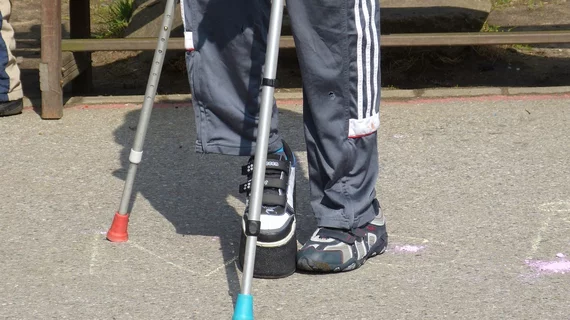Algorithm measures children’s leg-length discrepancies in 1 second
A deep learning algorithm has accurately measured 26 pairs of uneven leg lengths on children’s x-rays at a rate 96 times faster than that recorded by an experienced, subspecialty-trained pediatric radiologist using manual means.
The research producing the finding was conducted at Children’s Hospital of Philadelphia and published online April 21 in Radiology.
Corresponding author Raymond Wang Sze, MD, and colleagues used existing radiographs of 179 pediatric patients with leg-length discrepancies, dividing the images into sets for AI training, validation and testing.
In the training and validation sets, the deep learning model showed a high spatial overlap between manual and automatic segmentation masks of pediatric legs, the authors report. For the test set, correlations were strong between radiology reports and algorithmically calculated lengths of separated femurs and tibias, full legs and full leg-length discrepancies.
Next the team randomly chose 26 cases for reviewing task-completion times.
Per x-ray, they found, the algorithm did the job in just about one second flat. The mean per-image time for the radiologist was 96 seconds.
In their discussion, Sze and co-authors conclude that the task at hand “can be automated and performed rapidly by a deep learning algorithm. This will help make more efficient use of radiologists’ time and expertise.”
The algorithm they developed for the research, they add, has good potential for helping evaluate patients with orthopedic hardware (screws, pins, plates or wires). The team plans to build on its success by training the algorithm on more complex clinical presentations than they used for this first go-round.
In an accompanying Radiology opinion piece commenting on the Sze et al. study, Netherlands researchers Rick van Rijn, MD, PhD, of the University of Amsterdam and Alberto De Luca, PhD, of Utrecht University lay out three reasons why “artificial intelligence might be the radiologist’s best friend.”
First, 96 seconds per patient extrapolates to 4.8 hours for radiologists to measure all 179 cases used in the study. “One of the merits of this study is that it shows why radiologists should embrace deep learning systems,” van Rijn and De Luca write. “Once properly trained, a deep learning system can perform the same task in three minutes.”
The takeaway point: AI can free up a lot of time for radiologists to spend on value-adding duties that only humans can perform.
Next, the authors point out, the Sze et al. study shows that deep learning can learn from one expert how to perform segmentations with high accuracy, producing measures that are almost perfectly correlated to those derived by an expert.
“A drawback of the study is, as the authors acknowledge, the fact that there was no independent remeasurement of leg length. Thus, the accuracy of radiologists is unknown,” van Rijn and De Luca write. “Despite this limitation there is a second reason why radiologists should embrace AI: Deep learning may perhaps learn from consensus once and reapply such refined process on multiple occasions.”
Finally, they note, deep learning can be leveraged to democratize know-how and expand healthcare access.
“Once a learning system has been trained using the knowledge of experts or even consensus for a highly specialized task, it might be easily transferred to other hospitals, where specialist knowledge might be limited, or to developing countries using, for example, cloud-based services,” van Rijn and De Luca note.
The present study further shows, they conclude, that deep learning can play a role in pediatric radiology—“a subspecialty where, given the relatively low number of cases, adoption of deep learning is limited.”

